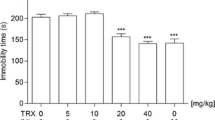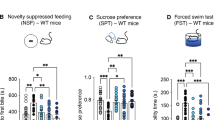Abstract
Serotonergic systems are thought to be involved in the mechanisms of action of antidepressants in humans. There is little evidence, however, to suggest that serotonin uptake blockers are efficacious in animal models of depression. To further explore the antidepressant activity of these drugs, four compounds from this class (citalopram, fluvoxamine, indalpine or zimelidine) were tested in rats subjected to helplessness training. Rats were first exposed to inescapable shocks and 48 h later, shuttle-box training was initiated to evaluate escape learning. Twice-daily IP injections of citalopram (1 mg/kg), fluvoxamine (4 mg/kg), indalpine (1 and 2 mg/kg) and zimelidine (1 and 2 mg/kg) reduced escape deficits in a manner similar to that produced by the tricyclic antidepressants desipramine and clomipramine. Reversal of escape deficit by serotonin uptake blockers was observed only when the drugs were administered after the shuttle-box sessions. At higher doses, the four serotonin uptake blockers were without effect. These data suggest that serotonin uptake blockers exert antidepressant-like effects in animals but only when they produce a moderate stimulation of serotonin neurotransmission.
Similar content being viewed by others
References
Aprison MH, Takahaski R, Tachiki K (1978) Hypersensitive serotonergic receptors involved in clinical depression — a theory. In: Haber B, Aprison M (eds) Neuropharmacology and behavior. Pergamon Press, New York, pp 23–53
Asberg M, Eriksson B, Martensson B, Träskman-Bendz L, Wagner A (1986) Therapeutic effects of serotonin uptake inhibitors in depression. J Clin Psychiatry [Suppl] 47:23–35
Broekkamp CL, Garrigou O, Lloyd KG (1980) Serotonin-mimetic and antidepressant drugs on passive avoidance learning by olfactory bulbectomized rats. Pharmacol Biochem Behav 13:643–646
Giral P, Martin P, Soubrié P, Simon P (1988) Reseveral of helpless behaviour in rats by putative 5-HT1A agonists. Biol Psychiatry 23:237–242
Goodwin GM, Green AR, Johnson P (1984) 5-HT2 receptor characteristics in frontal cortex and 5-HT2 receptor-mediated headtwitch behaviour following antidepressant treatment to mice. Br J Pharmacol 83:235–242
Hamon M, Gozlan, El Mestikawy S, Emerit MB, Cossery JM, Lutz O (1988) Biochemical properties of central serotonin receptors. In: Osborne NN, Hamon M (eds) Neural serotonin. Wiley New York, pp 392–422
Joly D, Sanger DJ (1986) The effects of fluoxetine and zimelidine on the behavior of olfactory bulbectomized rats. Pharmacol Biochem Behav 24:199–204
Kennett GA, Dourish CT, Curson G (1987) Antidepressant-like action of 5-HT1A agonists and conventional antidepressants in an animal model of depression. Eur J Pharmacol 134:265–274
Kraemer GW, Ebert MH, Lake CR, McKinney WT (1984) Cerebrospinal fluid measures of neurotransmitter changes associated with pharmacological alteration of the despair response to social separation in rhesus monkeys. Psychiatry Res 11:303–315
Kragh-Sorensen P, Le Fèvre Honoré P, Gram LF (1987) Therapeutic effect of selective 5-HT reuptake inhibitors in comparison with tricyclic antidepressants. In: Dahl SG, Gram LF, Paul SM, Potter WZ (eds) Clinical pharmacology in psychiatry. Springer, Berlin Heidelberg New York, pp 147–156
Lemberger L, Fuller RW, Zerbe RL (1985) Use of specific serotonin uptake inhibitors as antidepressants. Clin Neuropharmacol 8:299–317
McElroy JF, Du Pont AF, Feldman RS (1982) The effects of fenfluramine and fluoxetine on the acquisition of a conditioned avoidance response in rats. Psychopharmacology 77:356–359
Maier SF, Seligman MEP (1976) Learned helplessness. Theory and evidence. J Exp Psychol [Gen] 105:3–46
Maître L, Baumann PA, Jackel J, Waldmeier PC (1982) 5-HT uptake inhibitors: psychopharmacological and neurobiochemical criteria of selectivity in serotonin. In: Ho BT et al. (eds) Biological psychiatry. Raven Press, New York, pp 229–246
Martin P, Soubrié P, Simon P (1986) Shuttle-box deficits induced by inescapable shocks in rats: reversal by the beta-adrenoceptor stimulants clenbuterol and salbutamol. Pharmacol Biochem Behav 24:177–181
Martin P, Laporte A-M, Soubrié P, El Mestikawy S, Hamon M (1987a) Reversal of helpless behavior in rats by serotonin uptake inhibitors. International Conference on Behavioral Pharmacology of Serotonin, Amsterdam, November 24–27
Martin P, Soubrié P, Simon P (1987b) The effect of monoamine oxidase inhibitors compared with classical tricyclic antidepressants on learned helplessness paradigm. Prog Neuropsychopharmacol Biol Psychiatry 11:1–7
Martin P, Beninger R, Massol J, Laporte AM, El Mestikawy S, Soubrié P, Hamon M, Puech AJ (1988a) Antidepressant-like action of 8-OH DPAT, a 5-HT1A agonist, in the learned helplessness paradigm: pre- or post-synaptic mechanism? Abstract of the XVIth CINP Congress, Munich 15–19 August 1988, Psychopharmacology [Suppl] 96:S262
Martin P, Thiébot MH, Puech AJ (1988b) Various 5-HT receptor subtypes (5-HT1A, 5-HT1B, 5-HT2, 5-HT3) are involved in helpless behavior in rats. Réunion des Sociétés Française, Belge et Suisse de Pharmacologie. Congrès de Lausanne, 23–26 Mars 1988
Martin P, Massol J, Soubrié P, Puech AJ (1989) Effects of triiodothyronine (T3) on the potentiation by antidepressants of L-5-hydroxytryptophan-induced head-twitches in mice. Prog Neuropsychopharmacol Biol Psychiatry 13:735–748
Murphy DL, Campbell I, Costa JL (1978) Current status of the idoleamine hypothesis of affective disorders. In: Lipton MA, Di Mascio, Killam KF (eds) Psychopharmacology: a generation of progress. Raven Press, New York, pp 1234–1248
Ogren SO, Fuxe K, Agnati KF, Gustafson JA, Janssen G, Holm AC (1979) Reevaluation of the indoleamine hypothesis of depression. Evidence for a reduction of functional activity of central 5-HT systems by antidepressant drugs. J Neural Transm 46:85–103
Petty F, Sherman AD (1983) Learned helplessness induction decreases in vivo cortical serotonin release. Pharmacol Biochem Behav 18:649–650
Seligman MEP, Maier SF (1967) Failure to escape traumatic shock. J Exp Psychol 74:1–9
Sherman AD, Petty F (1980) Neurochemical basis of the action of antidepressants on learned helplessness. Behav Neural Biol 30:119–134
Sherman AD, Petty F (1982) Additivity of neurochemical changes in learned helplessness and imipramine. Behav Neural Biol 35:344–354
Sherman AD, Petty F (1984) Learned helplessness decreases (3H) imipramine binding in rat cortex. J Affective Disord 6:25–32
Sherman AD, Sacquitne JL, Petty F (1982) Specificity of the learned helplessness model of depression. Pharmacol Biochem Behav 16:449–454
Soubrié P (1986) Reconciling the role of central serotonin neurons in human and animal behavior. Brain Behav Sci 9:319–335
Soubrié P, Martin P, El Mestikawy S, Thiebot MH, Simon P, Hamon M (1986) The lesion of serotoninergic neurons does not prevent antidepressant-induced reversal of escape failurs produced by inescapable shocks in rats. Pharmacol Biochem Behav 25:1–6
Stéru L, Chermat R, Thierry B, Mico J-A, Lenegre A, Stéru M, Simon P, Porsolt RD (1987) The automated tail suspension test: a computerized device which differentiates psychotropic drugs. Prog Neuropsychopharmacol Biol Psychiatry 11:659–671
Telner JI, Singhal RL, Lapierre YD (1981) Reversal of learned helplessness by nortriptyline. Prog Neuropsychopharmacol Biol Psychiatry 5:587–590
Author information
Authors and Affiliations
Additional information
The results described here were presented at the International Conference on Behavioural Pharmacology of 5-HT, Amsterdam, November 24–27 1987, in preliminary form (Martin et al. 1987a)
Rights and permissions
About this article
Cite this article
Martin, P., Soubrié, P. & Puech, A.J. Reversal of helpless behavior by serotonin uptake blockers in rats. Psychopharmacology 101, 403–407 (1990). https://doi.org/10.1007/BF02244061
Received:
Revised:
Issue Date:
DOI: https://doi.org/10.1007/BF02244061




